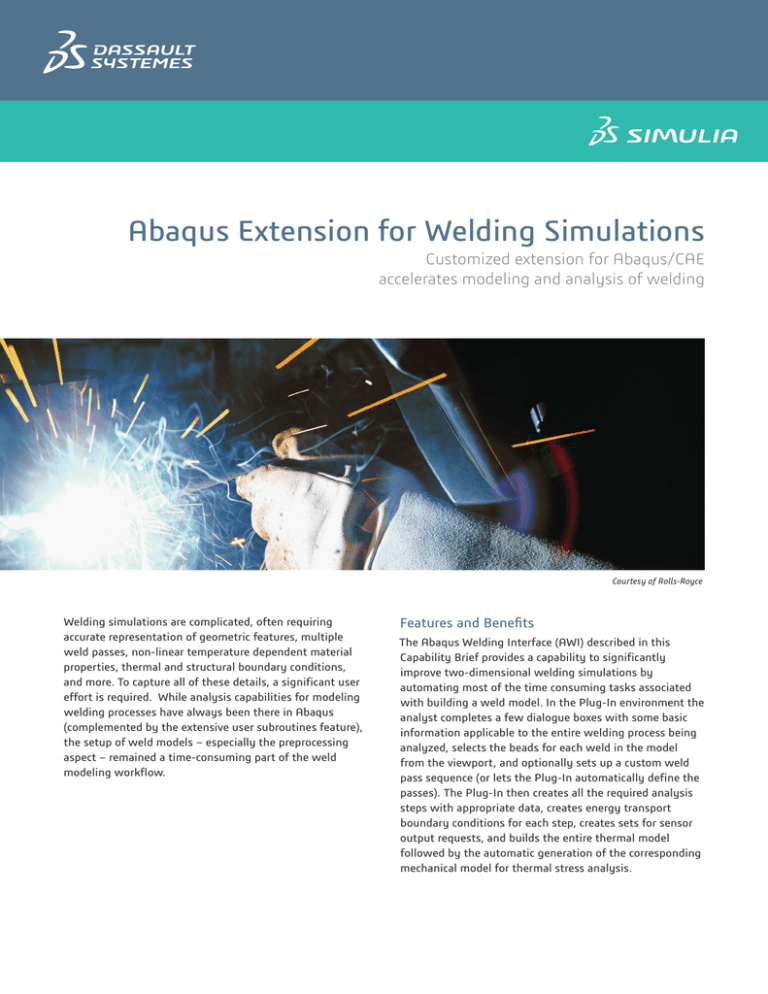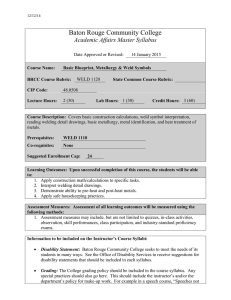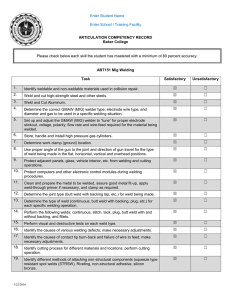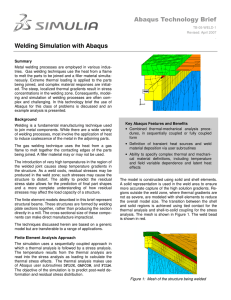
Abaqus Extension for Welding Simulations
Customized extension for Abaqus/CAE
accelerates modeling and analysis of welding
Courtesy of Rolls-Royce
Welding simulations are complicated, often requiring
accurate representation of geometric features, multiple
weld passes, non-linear temperature dependent material
properties, thermal and structural boundary conditions,
and more. To capture all of these details, a significant user
effort is required. While analysis capabilities for modeling
welding processes have always been there in Abaqus
(complemented by the extensive user subroutines feature),
the setup of weld models – especially the preprocessing
aspect – remained a time-consuming part of the weld
modeling workflow.
Features and Benefits
The Abaqus Welding Interface (AWI) described in this
Capability Brief provides a capability to significantly
improve two-dimensional welding simulations by
automating most of the time consuming tasks associated
with building a weld model. In the Plug-In environment the
analyst completes a few dialogue boxes with some basic
information applicable to the entire welding process being
analyzed, selects the beads for each weld in the model
from the viewport, and optionally sets up a custom weld
pass sequence (or lets the Plug-In automatically define the
passes). The Plug-In then creates all the required analysis
steps with appropriate data, creates energy transport
boundary conditions for each step, creates sets for sensor
output requests, and builds the entire thermal model
followed by the automatic generation of the corresponding
mechanical model for thermal stress analysis.
Weld Specification
•Multiple welds can be active in one model
•Once created, a weld can be deleted, edited, or renamed
Bead/Chunk Specification
•Selected by picking faces. In 3D, can be automatically
generated in swept geometry
•Once created, can be deleted, edited, and renamed
Pass Controls
•Allows default values for film loads, radiation loads, and
step incrementation for all passes
Pass Specification
•Passes can contain any number of beads or chunks from
any weld
•Can be chosen in 3 ways:
◦◦Automatically by assuming each bead/chunk is
assigned to one pass
◦◦Manually by picking regions
◦◦Manually by choosing weld name, bead name and
chunk name through Pass Manager
•Once created, the beads/chunks associated with a pass
can be deleted or modified
Pass Steps
•During each pass an Apply Torch and a Cool Down step
are automatically created.
transfer model
◦◦Creep - Visco step to stress model
◦◦User-Defined - empty step added to stress, heattransfer, or both models
Film and Radiation Loads
•Can be added to any surface of model, including beads
surface as they are inserted
•Can be modified or turned off at any step during the
analysis
•Are automatically removed on faces as they are covered
by beads
Obtaining Abaqus Welding Interface
The Abaqus Welding Interface is available for lease through
your local support office. The plug-in may be downloaded
at: http://www.simulia.com/products/welding.html
Installation instructions are provided in the documentation.
For More Information
A list of features is provided on the reverse side
of this summary. More specific information may
be obtained by downloading the documentation.
Support for the AWI is provided by the SIMULIA
Southern office in Dallas, Texas at 214-513-1600
and the SIMULIA Erie Region office in Cleveland,
Ohio at 216-378-1070
3DS.COM/SIMULIA
•All incrementation controls can be modified
•Additional available step types:
◦◦Reset Temperatures - Steady-state step to heat-
© Dassault Systèmes 2012, all rights reserved. CATIA, SolidWorks, ENOVIA, SIMULIA, DELMIA, 3DVIA, 3DSwYm, EXALEAD, and Netvibes are registered trademarks of Dassault Systèmes or its subsidiaries in the US and/or other countries.
Abaqus Extension for Welding Simulations




